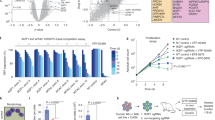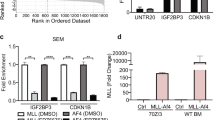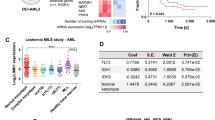Abstract
Chromosomal rearrangements of the mixed lineage leukemia (MLL/KMT2A) gene leading to oncogenic MLL-fusion proteins occur in ~10% of acute leukemias and are associated with poor clinical outcomes, emphasizing the need for new treatment modalities. Inhibition of the DOT1-like histone H3K79 methyltransferase (DOT1L) is a specific therapeutic approach for such leukemias that is currently being tested in clinical trials. However, in most MLL-rearranged leukemia models responses to DOT1L inhibitors are limited. Here, we performed deep-coverage short hairpin RNA sensitizer screens in DOT1L inhibitor-treated MLL-rearranged leukemia cell lines and discovered that targeting additional nodes of MLL complexes concomitantly with DOT1L inhibition bears great potential for superior therapeutic results. Most notably, combination of a DOT1L inhibitor with an inhibitor of the MLL–Menin interaction markedly enhanced induction of differentiation and cell killing in various MLL disease models including primary leukemia cells, while sparing normal hematopoiesis and leukemias without MLL rearrangements. Gene expression analysis on human and murine leukemic cells revealed that target genes of MLL-fusion proteins and MYC were suppressed more profoundly upon combination treatment. Our findings provide a strong rationale for a novel targeted combination therapy that is expected to improve therapeutic outcomes in patients with MLL-rearranged leukemia.
This is a preview of subscription content, access via your institution
Access options
Subscribe to this journal
Receive 12 print issues and online access
$259.00 per year
only $21.58 per issue
Buy this article
- Purchase on SpringerLink
- Instant access to full article PDF
Prices may be subject to local taxes which are calculated during checkout




Similar content being viewed by others
Accession codes
References
Slany RK . The molecular biology of mixed lineage leukemia. Haematologica 2009; 94: 984–993.
Muntean AG, Hess JL . The pathogenesis of mixed-lineage leukemia. Annu Rev Pathol 2012; 7: 283–301.
Krivtsov AV, Armstrong SA . MLL translocations, histone modifications and leukaemia stem-cell development. Nat Rev Cancer 2007; 7: 823–833.
Wang P, Lin C, Smith ER, Guo H, Sanderson BW, Wu M et al. Global analysis of H3K4 methylation defines MLL family member targets and points to a role for MLL1-mediated H3K4 methylation in the regulation of transcriptional initiation by RNA polymerase II. Mol Cell Biol 2009; 29: 6074–6085.
Hess JL . MLL: a histone methyltransferase disrupted in leukemia. Trends Mol Med 2004; 10: 500–507.
Okada Y, Feng Q, Lin Y, Jiang Q, Li Y, Coffield VM et al. hDOT1L links histone methylation to leukemogenesis. Cell 2005; 121: 167–178.
Bernt KM, Zhu N, Sinha AU, Vempati S, Faber J, Krivtsov AV et al. MLL-rearranged leukemia is dependent on aberrant H3K79 methylation by DOT1L. Cancer Cell 2011; 20: 66–78.
Guenther MG, Levine SS, Boyer LA, Jaenisch R, Young RA . A chromatin landmark and transcription initiation at most promoters in human cells. Cell 2007; 130: 77–88.
Milne TA, Martin ME, Brock HW, Slany RK, Hess JL . Leukemogenic MLL fusion proteins bind across a broad region of the Hox a9 locus, promoting transcription and multiple histone modifications. Cancer Res 2005; 65: 11367–11374.
Chang MJ, Wu H, Achille NJ, Reisenauer MR, Chou CW, Zeleznik-Le NJ et al. Histone H3 lysine 79 methyltransferase Dot1 is required for immortalization by MLL oncogenes. Cancer Res 2010; 70: 10234–10242.
Jo SY, Granowicz EM, Maillard I, Thomas D, Hess JL . Requirement for Dot1l in murine postnatal hematopoiesis and leukemogenesis by MLL translocation. Blood 2011; 117: 4759–4768.
Krivtsov AV, Feng Z, Lemieux ME, Faber J, Vempati S, Sinha AU et al. H3K79 methylation profiles define murine and human MLL-AF4 leukemias. Cancer Cell 2008; 14: 355–368.
Daigle SR, Olhava EJ, Therkelsen CA, Majer CR, Sneeringer CJ, Song J et al. Selective killing of mixed lineage leukemia cells by a potent small-molecule DOT1L inhibitor. Cancer Cell 2011; 20: 53–65.
Daigle SR, Olhava EJ, Therkelsen CA, Basavapathruni A, Jin L, Boriack-Sjodin PA et al. Potent inhibition of DOT1L as treatment of MLL-fusion leukemia. Blood 2013; 122: 1017–1025.
Yu W, Chory EJ, Wernimont AK, Tempel W, Scopton A, Federation A et al. Catalytic site remodelling of the DOT1L methyltransferase by selective inhibitors. Nat Commun 2012; 3: 1288.
Corcoran RB, Cheng KA, Hata AN, Faber AC, Ebi H, Coffee EM et al. Synthetic lethal interaction of combined BCL-XL and MEK inhibition promotes tumor regressions in KRAS mutant cancer models. Cancer Cell 2013; 23: 121–128.
Hoffman GR, Rahal R, Buxton F, Xiang K, McAllister G, Frias E et al. Functional epigenetics approach identifies BRM/SMARCA2 as a critical synthetic lethal target in BRG1-deficient cancers. Proc Natl Acad Sci USA 2014; 111: 3128–3133.
Konig R, Chiang CY, Tu BP, Yan SF, DeJesus PD, Romero A et al. A probability-based approach for the analysis of large-scale RNAi screens. Nat Methods 2007; 4: 847–849.
Schwaller J, Frantsve J, Aster J, Williams IR, Tomasson MH, Ross TS et al. Transformation of hematopoietic cell lines to growth-factor independence and induction of a fatal myelo- and lymphoproliferative disease in mice by retrovirally transduced TEL/JAK2 fusion genes. EMBO J 1998; 17: 5321–5333.
Mereau H, De Rijck J, Cermakova K, Kutz A, Juge S, Demeulemeester J et al. Impairing MLL-fusion gene-mediated transformation by dissecting critical interactions with the lens epithelium-derived growth factor (LEDGF/p75). Leukemia 2013; 27: 1245–1253.
Johnson JJ, Chen W, Hudson W, Yao Q, Taylor M, Rabbitts TH et al. Prenatal and postnatal myeloid cells demonstrate stepwise progression in the pathogenesis of MLL fusion gene leukemia. Blood 2003; 101: 3229–3235.
Ritchie ME, Phipson B, Wu D, Hu Y, Law CW, Shi W et al. Limma powers differential expression analyses for RNA-sequencing and microarray studies. Nucleic Acids Res 2015; 43: e47.
Guenther MG, Lawton LN, Rozovskaia T, Frampton GM, Levine SS, Volkert TL et al. Aberrant chromatin at genes encoding stem cell regulators in human mixed-lineage leukemia. Genes Dev 2008; 22: 3403–3408.
Harbinski F, Craig VJ, Sanghavi S, Jeffery D, Liu L, Sheppard KA et al. Rescue screens with secreted proteins reveal compensatory potential of receptor tyrosine kinases in driving cancer growth. Cancer Discov 2012; 2: 948–959.
Klaus CR, Iwanowicz D, Johnston D, Campbell CA, Smith JJ, Moyer MP et al. DOT1L inhibitor EPZ-5676 displays synergistic antiproliferative activity in combination with standard of care drugs and hypomethylating agents in MLL-rearranged leukemia cells. J Pharmacol Exp Ther 2014; 350: 646–656.
Chou TC . Drug combination studies and their synergy quantification using the Chou–Talalay method. Cancer Res 2010; 70: 440–446.
Lehar J, Zimmermann GR, Krueger AS, Molnar RA, Ledell JT, Heilbut AM et al. Chemical combination effects predict connectivity in biological systems. Mol Syst Biol 2007; 3: 80.
Daugaard M, Baude A, Fugger K, Povlsen LK, Beck H, Sorensen CS et al. LEDGF (p75) promotes DNA-end resection and homologous recombination. Nat Struct Mol Biol 2012; 19: 803–810.
Thiel AT, Blessington P, Zou T, Feather D, Wu X, Yan J et al. MLL-AF9-induced leukemogenesis requires coexpression of the wild-type Mll allele. Cancer Cell 2010; 17: 148–159.
Mishra BP, Zaffuto KM, Artinger EL, Org T, Mikkola HK, Cheng C et al. The histone methyltransferase activity of MLL1 is dispensable for hematopoiesis and leukemogenesis. Cell Rep 2014; 7: 1239–1247.
Grembecka J, He S, Shi A, Purohit T, Muntean AG, Sorenson RJ et al. Menin-MLL inhibitors reverse oncogenic activity of MLL fusion proteins in leukemia. Nat Chem Biol 2012; 8: 277–284.
Yokoyama A, Somervaille TC, Smith KS, Rozenblatt-Rosen O, Meyerson M, Cleary ML . The menin tumor suppressor protein is an essential oncogenic cofactor for MLL-associated leukemogenesis. Cell 2005; 123: 207–218.
Yokoyama A, Cleary ML . Menin critically links MLL proteins with LEDGF on cancer-associated target genes. Cancer Cell 2008; 14: 36–46.
Cermakova K, Tesina P, Demeulemeester J, El Ashkar S, Mereau H, Schwaller J et al. Validation and structural characterization of the LEDGF/p75-MLL interface as a new target for the treatment of MLL-dependent leukemia. Cancer Res 2014; 74: 5139–5151.
Borkin D, He S, Miao H, Kempinska K, Pollock J, Chase J et al. Pharmacologic inhibition of the Menin–MLL interaction blocks progression of MLL leukemia in vivo. Cancer Cell 2015; 27: 589–602.
Dawson MA, Prinjha RK, Dittmann A, Giotopoulos G, Bantscheff M, Chan WI et al. Inhibition of BET recruitment to chromatin as an effective treatment for MLL-fusion leukaemia. Nature 2011; 478: 529–533.
Zuber J, Shi J, Wang E, Rappaport AR, Herrmann H, Sison EA et al. RNAi screen identifies Brd4 as a therapeutic target in acute myeloid leukaemia. Nature 2011; 478: 524–528.
Jang MK, Mochizuki K, Zhou M, Jeong HS, Brady JN, Ozato K . The bromodomain protein Brd4 is a positive regulatory component of P-TEFb and stimulates RNA polymerase II-dependent transcription. Mol Cell 2005; 19: 523–534.
Garcia-Cuellar MP, Buttner C, Bartenhagen C, Dugas M, Slany RK . Leukemogenic MLL-ENL fusions induce alternative chromatin states to drive a functionally dichotomous group of target genes. Cell Rep 2016; 15: 310–322.
Placke T, Faber K, Nonami A, Putwain SL, Salih HR, Heidel FH et al. Requirement for CDK6 in MLL-rearranged acute myeloid leukemia. Blood 2014; 124: 13–23.
Lavau C, Szilvassy SJ, Slany R, Cleary ML . Immortalization and leukemic transformation of a myelomonocytic precursor by retrovirally transduced HRX-ENL. EMBO J 1997; 16: 4226–4237.
Chen W, Li Q, Hudson WA, Kumar A, Kirchhof N, Kersey JH . A murine Mll-AF4 knock-in model results in lymphoid and myeloid deregulation and hematologic malignancy. Blood 2006; 108: 669–677.
Stein EM, Tallman MS . Mixed lineage rearranged leukaemia: pathogenesis and targeting DOT1L. Curr Opin Hematol 2015; 22: 92–96.
Park G, Gong Z, Chen J, Kim JE . Characterization of the DOT1L network: implications of diverse roles for DOT1L. Protein J 2010; 29: 213–223.
Paggetti J, Largeot A, Aucagne R, Jacquel A, Lagrange B, Yang XJ et al. Crosstalk between leukemia-associated proteins MOZ and MLL regulates HOX gene expression in human cord blood CD34+ cells. Oncogene 2010; 29: 5019–5031.
Shen C, Jo SY, Liao C, Hess JL, Nikolovska-Coleska Z . Targeting recruitment of disruptor of telomeric silencing 1-like (DOT1L): characterizing the interactions between DOT1L and mixed lineage leukemia (MLL) fusion proteins. J Biol Chem 2013; 288: 30585–30596.
Deshpande AJ, Deshpande A, Sinha AU, Chen L, Chang J, Cihan A et al. AF10 regulates progressive H3K79 methylation and HOX gene expression in diverse AML subtypes. Cancer Cell 2014; 26: 896–908.
Shi A, Murai MJ, He S, Lund G, Hartley T, Purohit T et al. Structural insights into inhibition of the bivalent menin-MLL interaction by small molecules in leukemia. Blood 2012; 120: 4461–4469.
Kuhn MW, Song E, Feng Z, Sinha A, Chen CW, Deshpande AJ et al. Targeting chromatin regulators inhibits leukemogenic gene expression in NPM1 mutant leukemia. Cancer Discov 2016; 6: 1166–1181.
Sroczynska P, Cruickshank VA, Bukowski JP, Miyagi S, Bagger FO, Walfridsson J et al. shRNA screening identifies JMJD1C as being required for leukemia maintenance. Blood 2014; 123: 1870–1882.
Li Y, Wen H, Xi Y, Tanaka K, Wang H, Peng D et al. AF9 YEATS domain links histone acetylation to DOT1L-mediated H3K79 methylation. Cell 2014; 159: 558–571.
Schuhmacher M, Kohlhuber F, Holzel M, Kaiser C, Burtscher H, Jarsch M et al. The transcriptional program of a human B cell line in response to Myc. Nucleic Acids Res 2001; 29: 397–406.
Acknowledgements
We thank Conny Eckert and Gunnar Cario for providing ALL patient samples, as well as Marion Wiesmann, He Wang, Tingting Qing, Emilie Bard-Chapeau, Antoine de Weck and Thomas Radimerski for helpful comments on the manuscript as well as Sabrina Baltschukat for technical assistance. JS and HM were supported by grants from the Swiss National Science Foundation (SNF-31003A_149714/1), Cancer Research Switzerland (KFS-319-08-2012) and the Gertrude Von Meissner Foundation (Basel, Switzerland).
Author information
Authors and Affiliations
Corresponding author
Ethics declarations
Competing interests
CD, VJC, JG, BSE, GH, FN, SG, LB, MI, AP, CS, MM, WRS, FH and RT are or have been employees of Novartis. The other authors declare no conflict of interest.
Additional information
Supplementary Information accompanies this paper on the Leukemia website
Supplementary information
Rights and permissions
About this article
Cite this article
Dafflon, C., Craig, V., Méreau, H. et al. Complementary activities of DOT1L and Menin inhibitors in MLL-rearranged leukemia. Leukemia 31, 1269–1277 (2017). https://doi.org/10.1038/leu.2016.327
Received:
Revised:
Accepted:
Published:
Issue Date:
DOI: https://doi.org/10.1038/leu.2016.327
This article is cited by
-
Application of omics in the diagnosis, prognosis, and treatment of acute myeloid leukemia
Biomarker Research (2024)
-
Menin inhibitors for the treatment of acute myeloid leukemia: challenges and opportunities ahead
Journal of Hematology & Oncology (2024)
-
The epigenetic regulators EP300/CREBBP represent promising therapeutic targets in MLL-rearranged acute myeloid leukemia
Cell Death Discovery (2024)
-
CRISPR–ChIP reveals selective regulation of H3K79me2 by Menin in MLL leukemia
Nature Structural & Molecular Biology (2023)
-
Combinatorial targeting of menin and the histone methyltransferase DOT1L as a novel therapeutic strategy for treatment of chemotherapy-resistant ovarian cancer
Cancer Cell International (2022)



